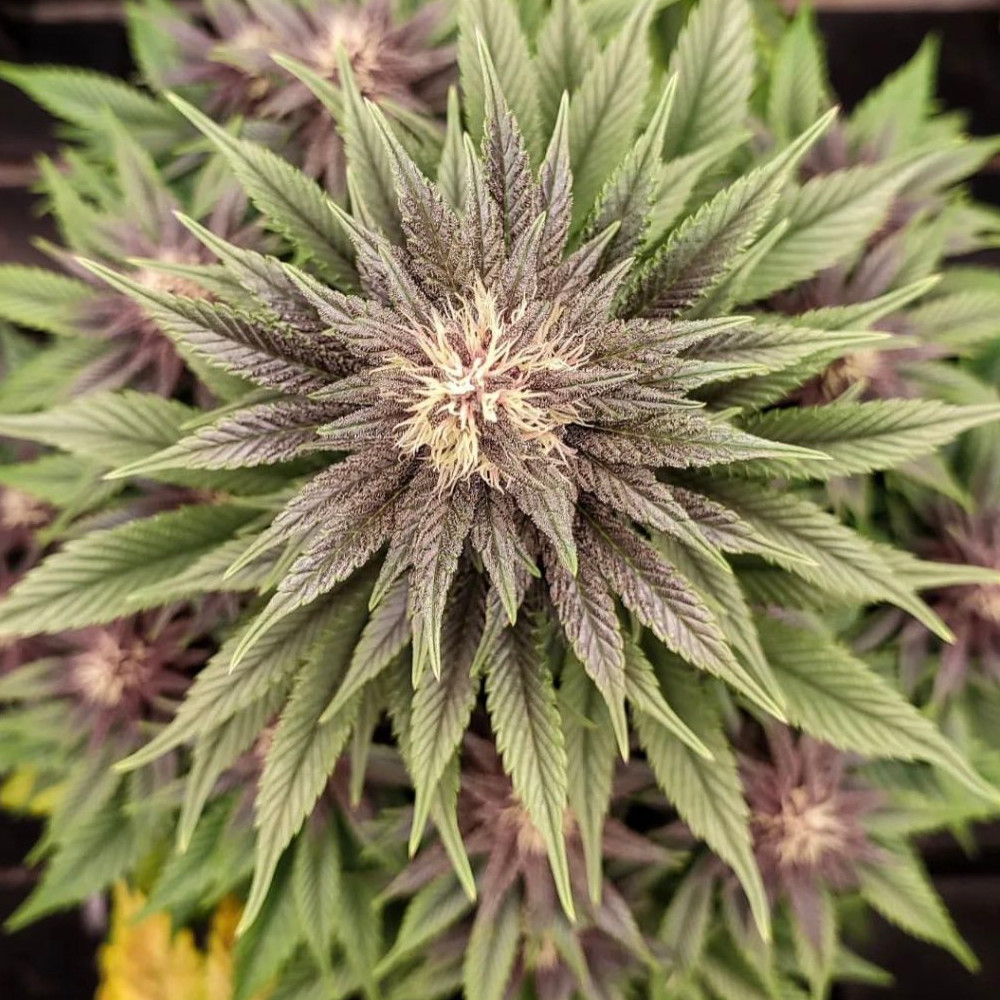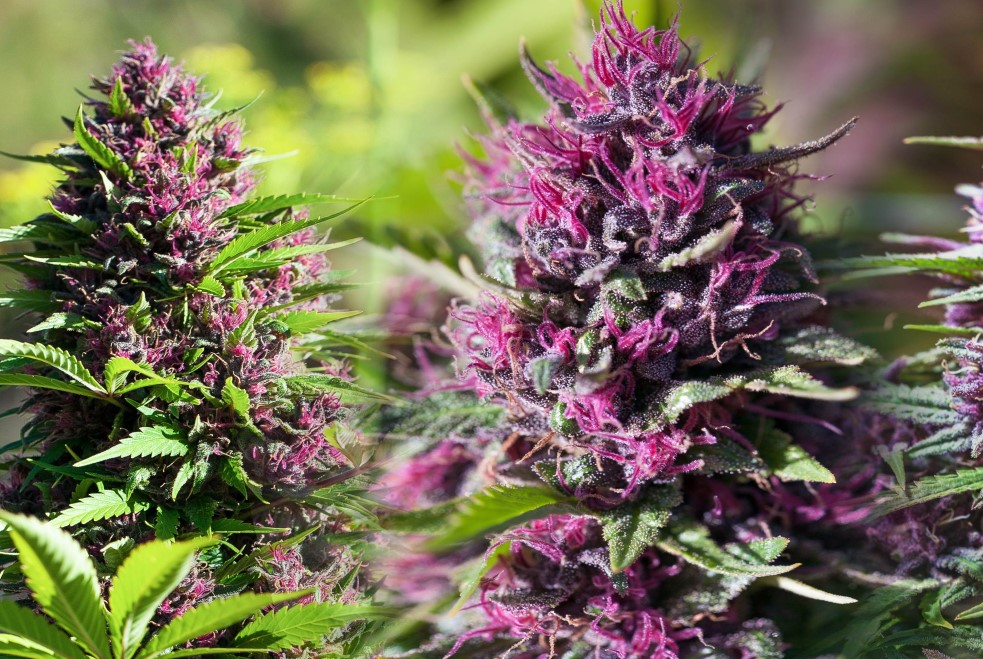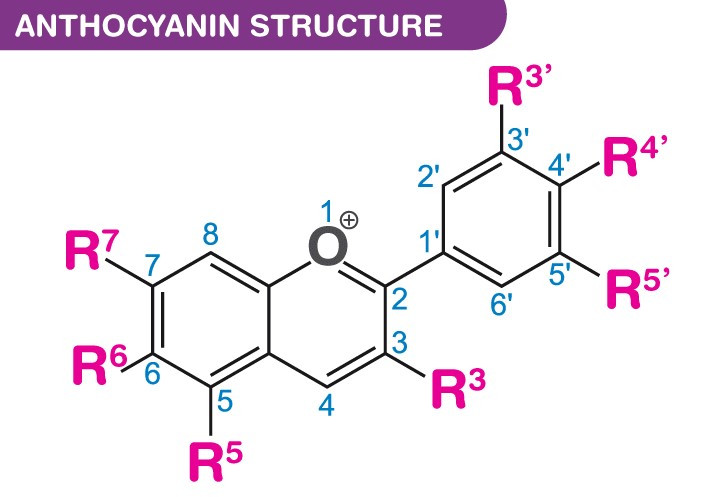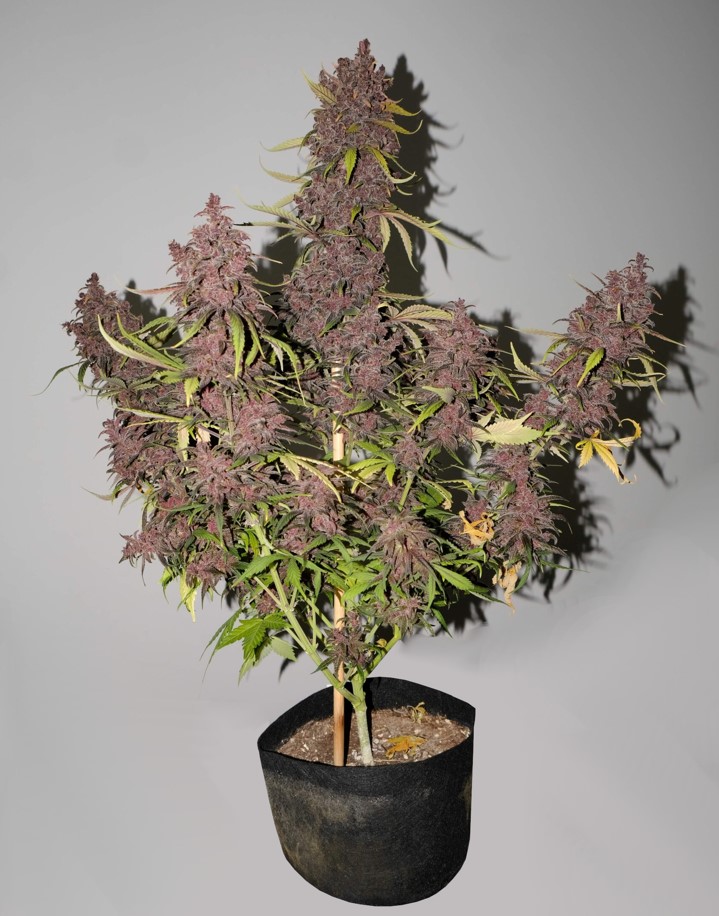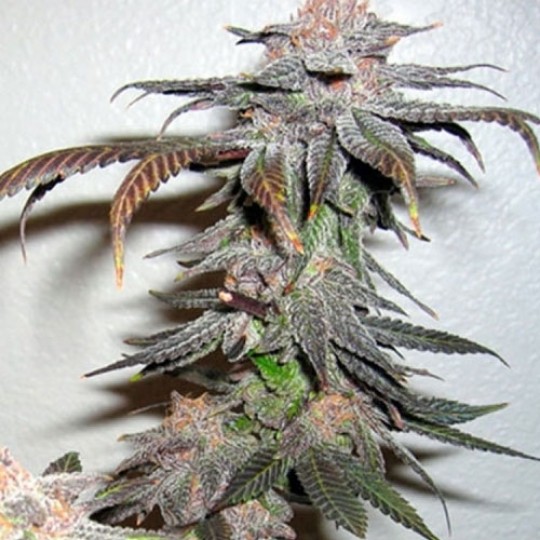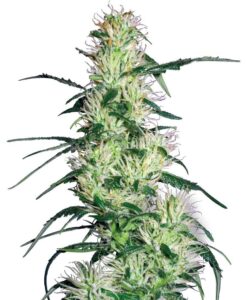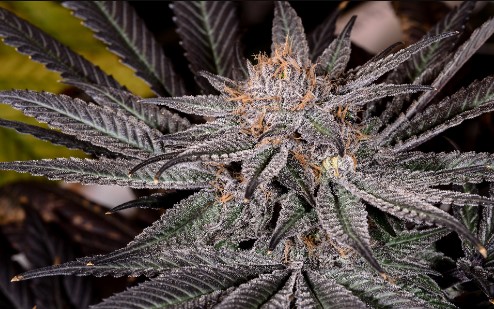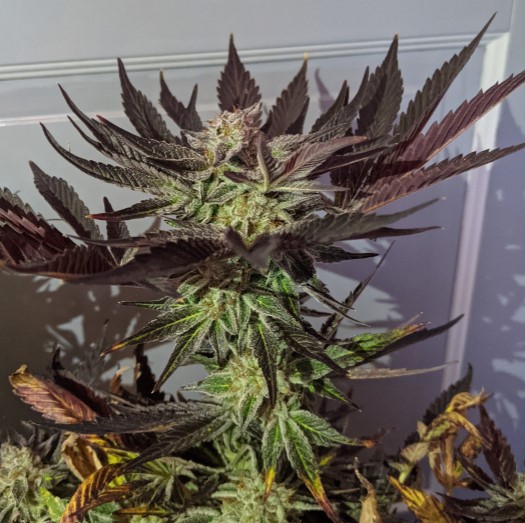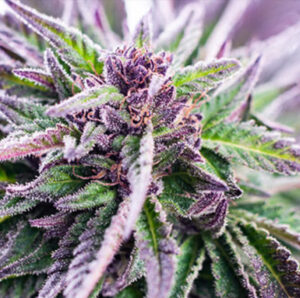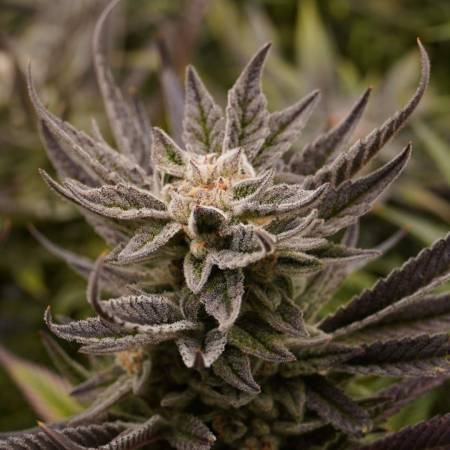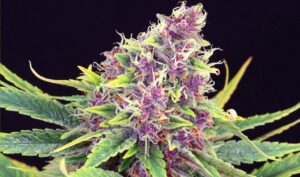Introduction
Purple strains of cannabis, with their mesmerizing hues, have enchanted cannabis enthusiasts for generations. Beyond their visual allure lies a complex interplay of genetics, environment, and biochemical processes that give rise to these vibrant colors. In this exploration, we venture into the captivating realm of purple buds, uncovering the science behind their striking appearance. Anthocyanins, water-soluble pigments responsible for the array of red, blue, and purple shades, play a pivotal role. Understanding their influence sheds light on the mystique of these strains, revealing a delicate balance between genetics and climate.
Our journey takes us through the legacy of classic purples like Purple Kush and Granddaddy Purple, delving into their origins, terpene profiles, and effects. We also navigate the landscape of modern strains—Grape Ape, Mendocino Purple, and Purple Space Cookies—each offering a unique sensory experience. Additionally, we explore the realm of balanced THC:CBD purples, like Purple Urkle, Lockdown Kush, and Black Harlequin, which blend therapeutic effects with a nuanced high, appealing to a diverse audience.
As we unravel the mysteries of purple cannabis, we probe into the evolving preferences within cannabis culture. What makes these strains so alluring? How do personal tastes and aesthetics influence strain choices? Looking ahead, we examine the trends and innovations shaping the future of purple cannabis. Join us in this vibrant odyssey, where science merges with culture, revealing a spectrum of possibilities as diverse and captivating as the hues themselves.
Table of Contents
The Science Behind Purple Buds: Anthocyanins
Explanation of Anthocyanins and Their Role in Producing Purple Hues
Influence of Climate and Genetics on Anthocyanin Production
Classic Purple Strains
a. Purple Kush
b. Granddaddy Purple (GDP)
c. Purple Haze
Modern Purple Strains
a. Grape Ape
b. Mendocino Purple
c. Purple Space Cookies
Balanced THC:CBD Purple Strains
a. Purple Urkle
b. Lockdown Kush
c. Black Harlequin
The Appeal of Purple Strains
The Science Behind Purple Buds: Anthocyanins
Explanation of Anthocyanins and Their Role in Producing Purple Hues
Introduction to Anthocyanins
Anthocyanins, Vibrant Pigments in Plants
Anthocyanins, a subgroup of flavonoids, are dazzling water-soluble pigments responsible for the striking red, blue, and purple hues found in various plants, including cannabis. These pigments serve not only aesthetic purposes but also essential biological functions within the plant. In cannabis, anthocyanins are predominantly present in flowers, leaves, and stems, with their production peaking during the flowering stage.
Anthocyanin Synthesis Process
From Genes to Colorful Buds: Anthocyanin Synthesis
The process of anthocyanin synthesis begins with the activation of specific genes in response to environmental signals. These genes orchestrate the production of anthocyanins within plant cells. These pigments accumulate in vacuoles, membrane-bound organelles within plant cells, imparting the distinct coloration observed in purple cannabis strains. The shades of purple are determined by the types and concentrations of anthocyanins present, along with other pigments and compounds within the plant.
Anthocyanins’ Role in Plant Survival
Anthocyanins as Natural Protectors and Regulators
Beyond their visual allure, anthocyanins play a crucial role in the plant’s survival. Functioning as natural protectants, these pigments shield the plant from stressors such as ultraviolet (UV) light and herbivores by absorbing and neutralizing harmful free radicals. Moreover, anthocyanins are believed to assist in regulating the plant’s response to environmental stress, enhancing its adaptability and resilience.
Significance in Cannabis Cultivation
Anthocyanins: Insights for Cultivators
In the realm of cannabis cultivation, understanding anthocyanins extends beyond their aesthetic appeal. These compounds offer valuable insights into the plant’s physiological responses to its surroundings. Growers can use this knowledge to optimize cultivation conditions, enhancing the expression of captivating purple hues in cannabis strains. Exploring the intricate relationship between anthocyanins, genetics, and environmental factors deepens our appreciation for these extraordinary strains, adding a layer of complexity to their allure.
Influence of Climate and Genetics on Anthocyanin Production
The mesmerizing purple hues adorning cannabis buds are not solely a product of chance; rather, they are intricately woven by the influence of both climate and genetics. Understanding the interplay between these factors provides valuable insights into the art and science of cultivating vibrant purple cannabis strains.
1. Climate:
Climate, particularly temperature, serves as a pivotal determinant in anthocyanin production. The expression of genes responsible for anthocyanin synthesis is significantly influenced by temperature fluctuations, especially during the flowering stage of cannabis plants. Cooler temperatures act as a catalyst, stimulating the activation of these genes and leading to an increase in anthocyanin production. In regions with colder climates, cannabis plants are more prone to displaying deep purple, blue, or reddish hues due to the enhanced synthesis of these water-soluble pigments.
Conversely, warmer temperatures tend to suppress the expression of genes related to anthocyanin production, resulting in cannabis plants that exhibit predominantly green coloration. Therefore, cultivating purple strains in environments with cooler nights, typical of continental climates, often yields buds with intense purple hues. Growers can manipulate temperature variations to encourage the development of these captivating colors, creating a visually striking harvest.
2. Genetics:
Genetics play a fundamental role in determining a cannabis plant’s potential to produce anthocyanins. Specific strains carry genetic traits that predispose them to express these vibrant pigments more prominently. Indica-dominant strains, in particular, often possess genetic lineage traced back to landrace varieties from regions with continental climates. These strains have adapted to cooler temperatures over generations, making them more inclined to produce anthocyanins in response to environmental cues.
Additionally, hybridization and selective breeding have enabled the development of specialized purple strains, such as Purple Kush and Granddaddy Purple, which showcase a remarkable genetic predisposition for vibrant coloration. By carefully selecting parent plants with strong anthocyanin-producing traits, breeders have cultivated new varieties that consistently exhibit striking purple hues, regardless of the climate in which they are grown.
In the hands of skilled cultivators and breeders, the intricate dance between climate and genetics becomes a canvas for artistic expression. By harnessing the power of these factors, cannabis enthusiasts can explore a diverse array of purple strains, each boasting a unique blend of genetics and environmental influences. As a result, the cultivation of purple cannabis continues to be a fascinating journey, where nature’s nuances and human ingenuity converge to create the captivating spectrum of colors that define these extraordinary buds.
Classic Purple Strains
a. Purple Kush
Genetics and Terpene Profile:
Purple Kush, a classic indica purple strain, traces its lineage to the Hindu Kush mountain range, an area renowned for producing potent cannabis varieties. This strain is a genetic blend of two landrace indica strains: Hindu Kush, a pure indica from the region after which it’s named, and Purple Afghani, a vibrant purple variety originating from the same area. This lineage gives Purple Kush its characteristic indica traits, including a soothing body high and dense, resinous buds.
| Purple Kush Seeds Strain Profile | ||
|---|---|---|
| Strain Genetics | Hindu Kush x Purple Afghani | |
| Strain Dominant | 75% Indica / 25% Sativa | |
| THC Content | 18 to 22% | |
| CBD Content | 0 to 1% | |
| Flowering Time | 8-9 weeks | |
| Flowering Type | Auto-flowering | |
| Yield | 300 to 450 grams per square meters indoors | |
| Taste / Flavor | Sweet, Berry, Pepper, Earthy, Pine | |
| Effects | Euphoric, Uplifting, Happy, Focused, Relaxing, Dry Eyes, Cottonmouth | |
| May Relieve | Stress, Anxiety, Depression, Chronic Pains, Fatigue, Migraines, Insomnia | |
| Best to Grow | Indoor, Greenhouse, Outdoor | |
The terpene profile of Purple Kush is notable for its earthy, sweet, and woody aroma, enhanced by the presence of terpenes like myrcene, caryophyllene, and humulene. Myrcene contributes to the strain’s relaxing effects, while caryophyllene adds a subtle spiciness. Humulene, with its earthy and woody notes, complements the overall aromatic profile, creating a sensory experience that is both comforting and enticing.
| Purple Kush Terpenes | Flavor/Smell | Percentage |
|---|---|---|
| Myrcene | Earthy, musky | 40-50% |
| Caryophyllene | Spicy, peppery | 10-15% |
| Pinene | Piney, fresh | 5-10% |
| Limonene | Citrusy, lemon-like | 1-2% |
| Linalool | Floral, lavender-like | 1-2% |
Growing Information and Ideal Conditions:
Purple Kush is favored by growers for its manageable growth characteristics and resilience, making it suitable for both indoor and outdoor cultivation. When cultivating Purple Kush indoors, providing a controlled environment with proper ventilation, temperature, and humidity levels is essential. Indoor growers often use techniques like low-stress training (LST) to encourage an even canopy and maximize light exposure to the budding sites.
Outdoors, Purple Kush thrives in a warm, Mediterranean-like climate with plenty of sunlight. This strain typically has a flowering period of around 7 to 9 weeks, during which the buds mature and develop their deep purple hues. As the plant approaches maturity, the leaves and buds transform into shades of purple, creating a visually striking spectacle.
To achieve the best results with Purple Kush, growers should monitor the plant’s nutrient intake, ensuring a balanced feeding schedule to promote healthy growth and vibrant coloration. Pruning and trimming can also enhance air circulation, reducing the risk of mold or mildew issues, especially in regions with higher humidity levels.
Cultivating Purple Kush is not only rewarding for its stunning appearance but also for the high-quality, relaxing effects it offers. As growers continue to refine their techniques, this classic indica purple strain remains a favorite among enthusiasts, showcasing the beauty and potency that define the world of purple cannabis.
b. Granddaddy Purple (GDP)
Origin and Awards:
Granddaddy Purple, often abbreviated as GDP, is a world-renowned indica strain that has earned its status as a classic in the cannabis community. This iconic strain was created by crossing two legendary indica varieties: Purple Urkle, a grape-flavored indica, and Big Bud, a heavy-yielding indica strain. The result of this crossbreeding is a visually stunning and profoundly relaxing strain that has become a staple in the medicinal and recreational cannabis markets.
Over the years, Granddaddy Purple has amassed numerous awards, solidifying its reputation as one of the best indica strains in the industry. It has claimed top honors at prestigious events such as the Green Cup and Denver High Times Cannabis Cup, further cementing its place in the cannabis hall of fame.
| Granddaddy Purple Strain Profile | ||
|---|---|---|
| Strain Genetics | Big Bud x Purple Urkle | |
| Strain Dominant | Mostly Indica – Indica 80% – Sativa 20% | |
| THC Content | 20- 27% | |
| CBD Content | 1% | |
| Flowering Time | 7-8 Weeks | |
| Flowering Type | Photoperiod | |
| Yield | Indoor 650 gr/m² / Outdoor up to 2kg per plant | |
| Taste / Flavor | CANDY, GRAPE, STRAWBERRY | |
| Effects | APPETITE, EUPHORIA, SPACY/CEREBRAL | |
| May Relieve | Arthritis, Stress, Depression, Insomnia, Migraines, Lack of Appetite, Chronic Pain | |
| Best to Grow | Indoor / Outdoor | |
Aroma, Flavor, and Effects:
Granddaddy Purple entices the senses with a rich and complex aroma. Its fragrance is characterized by a strong earthy base, complemented by sweet and fruity notes reminiscent of fresh grapes and berries. This delightful blend of scents makes GDP a truly aromatic experience, invoking a sense of anticipation with every whiff.
When it comes to flavor, Granddaddy Purple delivers a lusciously sweet taste profile. The dominant terpenes in GDP, myrcene, pinene, and caryophyllene, contribute to the strain’s distinct flavor profile. Notes of fresh grapes and sweet sugary candy dominate the palate, creating a mouthwatering experience for cannabis connoisseurs.
| Granddaddy Purple Terpenes | Flavor/Smell Description | Percentage |
|---|---|---|
| Myrcene | Earthy, musky | 55-60% |
| Caryophyllene | Spicy, peppery | 5-10% |
| Pinene | Piney, fresh | 5-10% |
| Limonene | Citrusy, lemon-like | 1-2% |
| Linalool | Floral, lavender-like | 1-2% |
Beyond its enticing aroma and flavor, Granddaddy Purple is renowned for its potent effects. Users can expect a soothing body stone that gradually spreads throughout the body, inducing a deep sense of relaxation and tranquility. The strain’s euphoric and uplifting cerebral effects are often accompanied by a boost in creativity and a heightened sense of happiness. As the high progresses, users may find themselves in a state of blissful lethargy, making GDP an ideal choice for unwinding after a long day or managing stress and pain.
Granddaddy Purple’s ability to induce relaxation and promote a positive mood has made it a popular choice among medical cannabis patients seeking relief from conditions such as chronic pain, insomnia, and anxiety. Its well-balanced effects and delightful flavor profile continue to captivate cannabis enthusiasts, solidifying its position as one of the most beloved and enduring indica strains in the world of cannabis.
c. Purple Haze
Historical Significance and Origin:
Purple Haze, an iconic strain named after the legendary Jimi Hendrix song of 1967, holds a special place in cannabis history. This strain gained prominence during the counterculture movement of the 1960s and 1970s, becoming synonymous with the psychedelic experiences of that era. While its exact origins remain somewhat mysterious, Purple Haze is believed to be a cross between Purple Thai and Haze, two renowned cannabis varieties.
| Purple Haze Strain Attribute | |
|---|---|
| Strain Genetics | Haze x Purple Thai |
| Strain Dominant | Sativa-dominant hybrid |
| THC Content | Approximately 17-20% |
| CBD Content | Low (typically < 1%) |
| Flowering Time | 9-10 weeks |
| Flowering Type | Photoperiod |
| Yield | Moderate to High |
| Taste / Flavor | Sweet, Earthy, Spicy,Berry, Herbal |
| Effects | Euphoric, Happy, Creative,Energetic, Uplifted, Relaxed |
| May Relieve | Stress, Depression,Fatigue, Pain, Headaches, Anxiety |
| Best to Grow | Indoor, Greenhouse,Outdoor |
The strain’s name and cultural significance are deeply rooted in the vibrant music and artistic scene of the 1960s, making Purple Haze a symbol of rebellion, creativity, and freedom. Its association with the legendary musician Jimi Hendrix further propelled its popularity, immortalizing the strain in the annals of cannabis culture.
Aroma, Flavor, and Effects:
Purple Haze tantalizes the senses with a captivating aroma that combines earthy notes with sweet berries and subtle hints of lavender. This unique terpene profile, featuring myrcene, caryophyllene, and limonene, contributes to the strain’s distinctive scent, evoking a sense of nostalgia and intrigue.
When it comes to flavor, Purple Haze offers a delightful blend of sweet and sour notes that coat the palate. The taste profile is characterized by a harmonious mix of sweetness and tartness, creating a mouthwatering experience for cannabis enthusiasts. The lingering aftertaste, reminiscent of berries and citrus, adds to the overall sensory pleasure of consuming Purple Haze.
| Purple Haze Terpenes | Flavor/Smell | Percentage |
|---|---|---|
| Myrcene | Earthy, musky | 45-55% |
| Caryophyllene | Spicy, peppery | 12-17% |
| Pinene | Piney, fresh | 5-10% |
| Limonene | Citrusy, lemon-like | 1-3% |
| Terpinolene | Sweet, floral | 1-2% |
Purple Haze is celebrated for its uplifting and euphoric effects, making it a favorite among creative individuals and socializers. Users often report an increased sense of happiness and enhanced creativity, accompanied by a burst of energy and sociability. The strain’s sativa-dominant nature contributes to its stimulating effects, making it an ideal choice for daytime use and social gatherings.
Additionally, Purple Haze is known for its potential to induce a sense of focus and clarity, making it popular among individuals seeking creative inspiration or relief from stress and fatigue. While its effects are predominantly cerebral, some users may also experience mild relaxation in the body, contributing to an overall sense of well-being.
As a strain with a rich cultural legacy and a delightful sensory profile, Purple Haze continues to captivate cannabis enthusiasts, offering a glimpse into the psychedelic spirit of the 1960s while providing a modern and enjoyable cannabis experience for users around the world.
Modern Purple Strains
a. Grape Ape
Genetic Composition and Flavor Profile:
Grape Ape is a modern indica purple strain celebrated for its striking purple hues, reminiscent of ripe grapes, and its sweet, fruity aroma. This delightful strain is a genetic blend of Mendocino Purps, Skunk, and an Afghani landrace indica, resulting in a well-balanced and flavorful cannabis variety.
The genetic composition of Grape Ape contributes to its unique terpene profile, which combines myrcene, caryophyllene, and humulene. These terpenes create an aroma reminiscent of fresh grapes and berries, accented by subtle earthy undertones. The flavor profile of Grape Ape mirrors its aroma, offering a delightful combination of sweet grape, berry, and floral notes. This exquisite taste experience makes Grape Ape a favorite among cannabis enthusiasts seeking a flavorful and aromatic indulgence.
| Terpene | Flavor/Smell | Percentage |
|---|---|---|
| Myrcene | Earthy, musky | 45-55% |
| Caryophyllene | Spicy, peppery | 20-25% |
| Pinene | Piney, fresh | 1-3% |
| Humulene | Woody, earthy | 1-2% |
| Terpinolene | Sweet, floral | 0.5-1% |
Effects
Grape Ape is renowned for its deeply relaxing and sedative effects, making it an ideal choice for evening use or when relaxation and stress relief are the primary goals. Users often report a sense of euphoria and bliss, accompanied by a gentle body high that soothes muscles and induces a state of calm. This strain is highly effective in relieving stress, anxiety, and insomnia, making it popular among medicinal cannabis users seeking natural relief from these conditions.
| Grape Ape Strain | |
|---|---|
| Strain Genetics | Afghani x Skunk x Mendocino Purps |
| Strain Dominant | Indica-dominant hybrid |
| THC Content | Approximately 18-21% |
| CBD Content | Low (typically < 1%) |
| Flowering Time | 7-8 weeks |
| Flowering Type | Photoperiod |
| Yield | Moderate to High (Indoors and Outdoors) |
| Taste / Flavor | Grape, Sweet, Berry, Earthy |
| Effects | Relaxing, Euphoric, Happy, Sleepy,Hungry |
| May Relieve | Stress, Pain, Insomnia, Anxiety,Depression, Hunger |
| Best to Grow | Indoor, Greenhouse, Outdoor |
Cultivation Tips:
In terms of cultivation, Grape Ape is known for its manageable growth characteristics and resilience, making it suitable for both indoor and outdoor cultivation. Indoors, growers can use techniques like low-stress training (LST) to encourage an even canopy and optimize light exposure to the budding sites. Maintaining a consistent temperature, humidity, and nutrient regimen is crucial for maximizing Grape Ape’s yield and potency.
Outdoors, Grape Ape thrives in a warm, Mediterranean-like climate with plenty of sunlight. It typically has a flowering period of around 7 to 8 weeks, during which the buds mature and develop their characteristic purple coloration. As the plant approaches maturity, the buds become densely packed with trichomes, enhancing their potency and resin production.
Cultivating Grape Ape is a rewarding experience, offering growers the opportunity to enjoy not only the visual spectacle of its vibrant purple buds but also the deeply relaxing and therapeutic effects it provides. With its exceptional flavor, aroma, and effects, Grape Ape continues to be a favorite among cannabis connoisseurs and medical users alike.
b. Mendocino Purple
Awards and Legacy:
Mendocino Purple, a strain that hails from the legendary Mendocino County in Northern California, has garnered significant acclaim within the cannabis community. This indica-dominant purple strain has a rich legacy, winning numerous awards and accolades that solidify its reputation as one of the finest cannabis varieties available. Its recognition includes the prestigious title of High Times’ Strain of the Year in 2007, a testament to its exceptional quality and popularity among cannabis enthusiasts.
| Mendocino Purple | |
|---|---|
| Strain Genetics | Unknown |
| Strain Dominant | Indica-dominant hybrid |
| THC Content | Approximately 15-20% |
| CBD Content | Low (typically < 1%) |
| Flowering Time | 8-9 weeks |
| Flowering Type | Photoperiod |
| Yield | Moderate to High |
| Taste / Flavor | Berry, Sweet, Earthy |
| Effects | Relaxed, Euphoric, Happy,Sleepy, Hungry |
| May Relieve | Stress, Pain, Insomnia,Anxiety, Depression,Lack of Appetite |
| Best to Grow | Indoor, Greenhouse,Outdoor |
The strain’s legacy extends beyond its awards, rooted in the fertile soil of Mendocino County, an area renowned for producing top-quality cannabis. Mendocino Purple’s reputation for potency, flavor, and vibrant purple hues has made it a favorite among growers and consumers alike, contributing to its enduring status as a classic purple strain.
Terpene Profile and Growing Requirements:
Mendocino Purple boasts a unique and enticing terpene profile that adds to its allure. The strain is characterized by a terpene composition that includes myrcene, pinene, and caryophyllene. Myrcene contributes to the strain’s relaxing effects, making it a popular choice for those seeking stress relief and relaxation. Pinene adds a touch of herbal and pine notes, enhancing the strain’s aromatic complexity. Caryophyllene, with its spicy and peppery undertones, completes the terpene profile, creating a well-rounded and delightful sensory experience.
| Terpene | Flavor/Smell Description | Percentage |
|---|---|---|
| Myrcene | Earthy, musky | 30-35% |
| Pinene | Herbal, pine | 25-30% |
| Caryophyllene | Spicy, peppery | 20-25% |
| Limonene | Citrusy, lemon-like | 5-10% |
| Humulene | Woody, earthy | 5-10% |
| Terpinolene | Herbal, floral | 5-10% |
When it comes to cultivation, Mendocino Purple thrives in temperate climates, making it an excellent choice for outdoor growers in regions with mild, Mediterranean-like weather. The strain prefers a sunny and warm environment, allowing it to express its full potential in terms of color, flavor, and potency. Cultivators should ensure a consistent feeding schedule and monitor environmental factors such as temperature and humidity to optimize the plant’s growth and resin production.
Mendocino Purple typically has a flowering period of around 8 to 9 weeks, during which its buds undergo a stunning transformation, displaying deep green leaves contrasted by vibrant purple hues. The strain’s dense and resinous buds are often accompanied by an intense aroma, combining earthy, herbal, and fruity notes.
Cultivating Mendocino Purple is a rewarding endeavor for growers seeking a high-quality, visually appealing, and flavorful cannabis strain. Its rich terpene profile, coupled with its impressive awards and legacy, make it a standout choice for both recreational and medicinal users, embodying the essence of Mendocino County’s cannabis excellence.
c. Purple Space Cookies
Breeding Details and Terpene Composition:
Purple Space Cookies is a contemporary indica purple strain that exemplifies the artistry of cannabis breeding. This hybrid strain is the result of crossing the iconic Girl Scout Cookies, known for its potency and delightful flavor, with the mysterious and exotic Durban Poison. This careful genetic combination results in a strain that not only exhibits captivating purple hues but also inherits the best qualities from its renowned parent strains.
Purple Space Cookies boasts a terpene composition dominated by caryophyllene, limonene, and myrcene. Caryophyllene lends the strain its peppery and spicy notes, enhancing both aroma and flavor profiles. Limonene contributes citrusy and zesty undertones, adding a refreshing twist to the sensory experience. Myrcene, with its earthy and musky aroma, enhances the overall complexity of Purple Space Cookies’ terpene profile, making it a delight for the senses.
| Terpene | Flavor/Smell Description | Percentage |
|---|---|---|
| Caryophyllene | Spicy, peppery | 25-30% |
| Limonene | Citrusy, lemon-like | 20-25% |
| Myrcene | Earthy, musky | 15-20% |
| Pinene | Piney, fresh | 5-10% |
| Linalool | Floral, lavender-like | 5-10% |
| Humulene | Woody, earthy | 5-10% |
| Terpinolene | Herbal, floral | 5-10% |
Effects and Suitable Environments:
Purple Space Cookies is celebrated for its well-balanced effects that blend relaxation with euphoria, making it a favorite among cannabis enthusiasts seeking a harmonious experience. Users often report a gentle onset of cerebral euphoria, coupled with a soothing body high that promotes relaxation without inducing overwhelming sedation. This balanced high makes Purple Space Cookies suitable for various occasions, whether it’s unwinding after a long day or socializing with friends.
Cultivators find Purple Space Cookies to be a versatile and adaptable strain. It thrives both indoors and outdoors, making it accessible to a wide range of growers. When cultivated indoors, growers can optimize the growing environment, including light cycles and temperature, to maximize yields and resin production. Outdoors, Purple Space Cookies flourishes in a warm, Mediterranean-like climate with plenty of sunlight. Its resilience to common pests and diseases, coupled with its manageable height, makes it an attractive choice for outdoor cultivation.
Purple Space Cookies Strain Chart
| Strain Genetics | Girl Scout Cookies x Durban Poison |
| Strain Dominant | Hybrid |
| THC Content | Approximately 18-22% |
| CBD Content | Low (typically < 1%) |
| Flowering Time | 8-9 weeks |
| Flowering Type | Photoperiod |
| Yield | Moderate |
| Taste / Flavor | Sweet, Berry, Earthy,Vanilla |
| Effects | Euphoric, Happy,Relaxed, Uplifted,Creative |
| May Relieve | Stress, Anxiety,Lack of Appetite,Pain, Depression |
| Best to Grow | Indoor, Greenhouse,Outdoor |
The strain typically has a flowering period of approximately 8 to 9 weeks, after which its buds develop deep purple hues, further enhancing its visual appeal. The dense and resinous buds, coupled with the strain’s delightful terpene profile, create a rewarding cultivation experience for growers and a sensory delight for consumers.
Purple Space Cookies stands as a testament to the innovative world of cannabis breeding, offering users a harmonious blend of flavors, colors, and effects. Its versatility in cultivation and balanced effects continue to make it a sought-after strain among cannabis enthusiasts looking for a well-rounded and enjoyable cannabis experience.
Balanced THC:CBD Purple Strains
a. Purple Urkle
History and Genetic Speculation:
Purple Urkle, a classic purple strain, has been captivating cannabis enthusiasts since the 1980s. While its exact genetic lineage remains a subject of speculation, Purple Urkle is believed to be a phenotype of either Mendocino Purps or Granddaddy Purple, both renowned indica strains. Its name reflects its vibrant purple coloration and distinctive aroma.
| Purple Urkle Strain | ||
|---|---|---|
| Strain Genetics | Mendocino Purps | |
| Strain Dominant | Mostly Indica | |
| THC Content | 27% | |
| CBD Content | <1% | |
| Flowering Time | 8 to 9 weeks | |
| Flowering Type | Photoperiod | |
| Yield | up to 450g/m² | |
| Taste / Flavor | Berry, Earthy, Herbal, Pepper, Pine | |
| Effects | Euphoric, Powerful, Relaxing, Sedative | |
| May Relieve | Anxiety, Depression, Insomnia, Pain, Stress | |
| Best to Grow | Indoor | Outdoor | Greenhouse | |
Over the years, Purple Urkle has earned a reputation for its balanced THC:CBD ratio, making it a favorite among users seeking the therapeutic benefits of both cannabinoids. Its origins in Northern California’s Emerald Triangle, an area famed for high-quality cannabis cultivation, have contributed to its enduring legacy and popularity.
Flavor, Effects, and Growing Information:
Purple Urkle enchants the senses with a delightful terpene profile. Its aroma is a harmonious blend of dank, musky notes layered with sweet undertones of fresh grapes and berries. This aromatic complexity carries over to its flavor, where users are treated to a rich and flavorful smoke infused with sweet and fruity notes, making it a pleasure for the palate.
| Terpene | Flavor/Smell Description | Percentage |
|---|---|---|
| Myrcene | Earthy, musky | 20-30% |
| Pinene | Piney, fresh | 10-15% |
| Caryophyllene | Spicy, peppery | 5-10% |
| Linalool | Floral, lavender-like | 1-2% |
| Humulene | Woody, earthy | 0.5-1.5% |
| Terpinolene | Herbal, floral | 0.5-1.5% |
In terms of effects, Purple Urkle delivers a clear-headed and cerebral high, promoting relaxation and mental tranquility without inducing excessive sedation. Its balanced THC:CBD ratio ensures a gentle and calming experience, making it suitable for users seeking relief from anxiety, stress, and mild pain. The strain’s effects are typically soothing and can enhance focus and creativity, making it a versatile choice for various situations.
Cultivating Purple Urkle requires attention to detail and patience. The strain thrives in temperate climates with consistent sunlight. It has a relatively short flowering period, usually around 8 to 9 weeks, during which its buds develop deep purple hues, adding to its visual allure. Purple Urkle plants tend to be compact with broad fan leaves and tight internodal spacing. Growers should monitor environmental factors such as temperature and humidity to ensure optimal growth and resin production.
For those seeking a balanced and enjoyable cannabis experience, Purple Urkle stands as a testament to the therapeutic potential of balanced THC:CBD strains. Its flavorful profile, relaxing effects, and vibrant appearance continue to make it a cherished choice among cannabis enthusiasts and patients alike.
b. Lockdown Kush
Origins and Unique Characteristics:
Lockdown Kush, a distinctive indica-dominant strain, emerged as part of a research collection, showcasing the innovation and expertise of cannabis breeders. This hybrid strain is a genetic blend of San Fernando Valley OG, prized for its potent effects, and Afghani #1, a classic indica strain known for its resilience and relaxing properties. The careful fusion of these parent strains results in Lockdown Kush, a cultivar celebrated for its balanced THC:CBD ratio and unique set of characteristics.
| Lockdown Kush | |
|---|---|
| Strain Genetics | Afghan Kush x OG Kush |
| Strain Dominant | Indica |
| THC Content | Approximately 18-22% |
| CBD Content | Low (typically < 1%) |
| Flowering Time | 8-9 weeks |
| Flowering Type | Photoperiod |
| Yield | Moderate to High |
| Taste / Flavor | Earthy, Woody, Pine,Citrus |
| Effects | Relaxing, Euphoric, Happy,Sleepy, Hungry |
| May Relieve | Stress, Pain, Insomnia,Anxiety, Depression,Lack of Appetite |
| Best to Grow | Indoor, Greenhouse,Outdoor |
One of the unique traits of Lockdown Kush is its ability to provide a well-balanced high, combining the relaxing effects of indica strains with the clarity and focus associated with certain sativas. This balance makes Lockdown Kush a versatile choice for users seeking a harmonious blend of relaxation and mental alertness.
Aroma, Effects, and Cultivation Insights:
Lockdown Kush captivates the senses with a sweet aroma infused with subtle notes of fresh lemons. This delightful fragrance carries over to its flavor profile, creating a pleasant and flavorful smoke. Users often report a highly potent and full-bodied high after consuming Lockdown Kush. The initial onset induces an uplifting euphoria, gradually spreading throughout the body and culminating in a muscle-relaxing body stone. This balanced combination of effects ensures a calming experience without excessive sedation, making Lockdown Kush suitable for various occasions.
| Terpene | Flavor/Smell Description | Percentage |
|---|---|---|
| Myrcene | Earthy, musky | 25-35% |
| Caryophyllene | Spicy, peppery | 15-20% |
| Pinene | Piney, fresh | 10-15% |
| Limonene | Citrusy, lemon-like | 5-10% |
| Humulene | Woody, earthy | 5-10% |
| Terpinolene | Herbal, floral | 2-5% |
Cultivating Lockdown Kush demands attention to environmental factors and a well-rounded approach to care. The strain can be grown both indoors and outdoors, thriving in colder, continental climates. Indoors, growers should maintain a controlled environment with optimal temperature and humidity levels. The plants have short internodal spacing, sturdy branches, broad fan leaves, and dense foliage, requiring regular pruning and trimming to enhance air circulation.
Outdoors, Lockdown Kush benefits from a sunny and cool climate, allowing it to express its full genetic potential. The strain typically has an average flowering period of up to 65 days, during which its buds develop impressive resin production and a vibrant purple coloration, adding to its visual appeal.
Lockdown Kush’s ability to deliver a balanced and potent experience, coupled with its pleasant aroma and resilient growth traits, has made it a standout choice among cannabis connoisseurs. Its harmonious effects and cultivation adaptability continue to make it a sought-after strain for users seeking a well-rounded and enjoyable cannabis experience.
c. Black Harlequin
Parent Strains and Cannabinoid Balance:
Black Harlequin is a unique and intriguing strain that results from the crossbreeding of two award-winning parent strains: Black Domina and Harlequin. Black Domina, an indica powerhouse, contributes to the strain’s bold and robust genetic foundation. Harlequin, on the other hand, is celebrated for its high CBD content, making it a standout among balanced strains. The combination of these parent strains results in a cultivar with a well-balanced THC:CBD ratio, specifically designed to provide users with a blend of therapeutic benefits and a clear-headed experience.
| Black Harlequin | |
|---|---|
| Strain Genetics | Black Domina x Harlequin |
| Strain Dominant | Indica-dominant hybrid |
| THC Content | Approximately 15-20% |
| CBD Content | High (typically > 5%) |
| Flowering Time | 8-9 weeks |
| Flowering Type | Photoperiod |
| Yield | Moderate |
| Taste / Flavor | Earthy, Sweet, Spicy,Woody, Citrus |
| Effects | Relaxed, Happy, Uplifted,Euphoric, Creative |
| May Relieve | Stress, Pain, Inflammation,Anxiety, Depression,Muscle Spasms |
| Best to Grow | Indoor, Greenhouse,Outdoor |
The strain’s balanced cannabinoid profile ensures that users can enjoy the potential benefits of both THC and CBD, making it an attractive choice for those seeking relief from various medical conditions while maintaining mental clarity.
Terpene Profile, Effects, and Growth Expectations:
Black Harlequin’s terpene profile is characterized by floral notes, earthy undertones, and hints of sweet pine. This delightful combination of terpenes adds depth and complexity to the strain’s aroma and flavor. Users often report a sensory experience enriched by these terpenes, making Black Harlequin an enjoyable strain to consume.
| Terpene | Flavor/Smell Description | Percentage |
|---|---|---|
| Myrcene | Earthy, musky | 20-25% |
| Caryophyllene | Spicy, peppery | 15-20% |
| Pinene | Piney, fresh | 10-15% |
| Limonene | Citrusy, lemon-like | 8-12% |
| Humulene | Woody, earthy | 7-10% |
| Terpinolene | Herbal, floral | 5-8% |
In terms of effects, Black Harlequin is known for providing a clear-headed and cerebral high that is accompanied by soothing and relaxing bodily sensations. The strain’s balanced THC:CBD ratio ensures that users can experience a gentle and uplifting euphoria without feeling overwhelmed by psychoactive effects. This makes Black Harlequin a versatile choice for a wide range of users, including those seeking relief from anxiety, pain, and inflammation.
Cultivating Black Harlequin can be a rewarding endeavor, provided growers follow specific guidelines. The strain typically thrives in environments with a moderate climate, where it can receive ample sunlight. It has a relatively average flowering time, which can vary but is generally around 8 to 9 weeks. During this period, its buds develop a unique blend of dark green and purple hues, contributing to its visual appeal.
Due to its balanced cannabinoid profile and potential therapeutic benefits, Black Harlequin has gained popularity among medicinal cannabis users. Its flavor, effects, and adaptability to different growing conditions make it a compelling choice for individuals seeking a harmonious and well-rounded cannabis experience while harnessing the potential healing properties of both THC and CBD.
The Appeal of Purple Strains
Reasons Behind the Popularity of Purple Cannabis:
Purple strains of cannabis have captured the hearts of enthusiasts and cultivators alike for several compelling reasons. The vibrant purple hues exhibited by these strains result from the presence of anthocyanins, water-soluble pigments found in the plant. Beyond their visual appeal, purple strains often boast unique flavor profiles and a well-balanced combination of cannabinoids and terpenes, making them highly sought after among consumers.
One of the primary reasons for the popularity of purple cannabis is its aesthetic allure. The rich, royal colors of purple buds evoke a sense of mystique and elegance, setting them apart from their green counterparts. This visual appeal creates an immediate attraction for consumers who appreciate the beauty of the plant as much as its effects.
Additionally, the presence of anthocyanins not only contributes to the purple coloration but also adds potential health benefits. These compounds, found in various fruits and vegetables, are known for their antioxidant properties, making purple cannabis strains not only visually captivating but potentially beneficial for health-conscious users.
Beyond aesthetics, purple strains often feature unique flavor profiles that can include notes of berries, grapes, and other fruits. The combination of visually stunning buds and delightful flavors creates a sensory experience that appeals to cannabis connoisseurs seeking a distinct and enjoyable taste.
Furthermore, some purple strains are bred to exhibit balanced THC:CBD ratios, providing users with the therapeutic benefits of both cannabinoids. This balanced approach appeals to medical cannabis users seeking relief from various ailments without the overwhelming psychoactive effects commonly associated with high-THC strains.
Factors Influencing Strain Choice: Personal Preferences and Aesthetics:
When it comes to choosing a cannabis strain, personal preferences play a significant role. Individuals may gravitate towards purple strains due to their unique appearance and the promise of a distinct flavor experience. For some, the desire to explore the potential health benefits associated with anthocyanins and other compounds found in purple cannabis serves as a motivating factor.
Aesthetics also play a crucial role in strain choice. Many consumers are drawn to the visual appeal of purple buds, finding them visually striking and alluring. The coloration often reflects the plant’s genetics, environmental conditions, and specific cultivation techniques, adding to the mystique of the strain.
Future Trends in Purple Strain Development:
As cannabis cultivation techniques continue to advance, the development of new and exotic purple strains is likely to flourish. Breeders are constantly experimenting with different genetic combinations to enhance not only the color but also the flavor, aroma, and effects of purple cannabis. Additionally, the growing interest in terpene profiles and their impact on the overall cannabis experience is expected to influence the development of future purple strains.
Furthermore, the ongoing research into the potential health benefits of anthocyanins and other compounds found in purple cannabis may lead to the creation of strains specifically tailored to address certain medical conditions. As the cannabis industry becomes more sophisticated, consumers can expect a wider array of purple strains that cater to diverse tastes and preferences, ensuring a vibrant and exciting future for purple cannabis enthusiasts.

